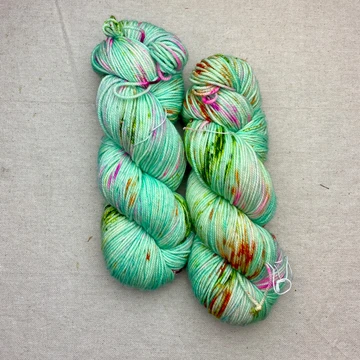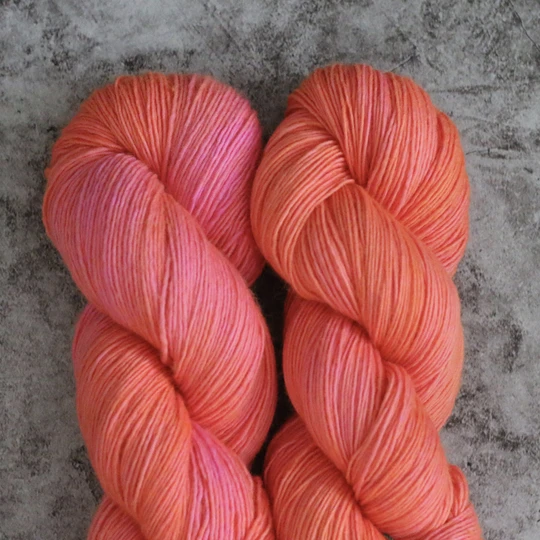Vacation Butterfly: Blocking
Do you have any recommendations for blocking this design? Tips and tricks to make blocking a success.
Do you have any special recommendations for blocking this garment?
This shawl was so large that inevitably I don’t have any good pictures of it being blocked. I think the best pictures to show how it was blocked are from my test knitters. One is attached below from my dear friend Vanessa.
I firmly believe that any blocking is a very stylistic choice. You are not at all required to block it the way I did. In fact many of you might have better ideas of how to block it that I might be envious of. So don’t feel that my suggestions are the way to go. My samples were blocked the same way for consistency and I asked my test knitters and sample knitters to do the same. My aims in blocking the way I did were to open up the bottom of the shawl and allow you to see all aspects of the design.
Because some yarns will bleed I do not use soak wash or any detergent. Bleeding usually relates to the ph level of your water. It does not necessarily relate to whether or not the yarn was dyed correctly. So, finding out you have the right ph level in your water by soak washing and having something bleed can be a terrible way to discover this. The addition of soak wash or wool wash can adversely impact the ph level and make things even worse. I choose to use only cold water in this process. I like to use the washing machine and the rinse + spin cycle. This thoroughly wets my knitting and the spin cycle gets most of the water out. This benefits my drying time and it also means that I'm never picking up my knitting when it is so wet that I will stretch my piece. I love it! I feel that this is the simplest way to “wash” your work before blocking.
One of the best articles I’ve read about the science behind ph levels in water and how they effect yarn is by Kimber Baldwin and found at https://fiberopticyarns.com/blogs/latest-news/how-to-wash-items-made-with-hand-dyed-yarns-or-fiber
Vacation Butterfly: Yarn Choices
What are your yarn recommendations for the Vacation Butterfly Shawl? Learn more in this blog post.
The simplest approach to choosing yarn for this shawl is to select Urth Monokrom or Urth Uneek. The reason I enjoy working with these fibers is that the the color choices are made for you through the yarn. If you choose instead to work with separate colors, you will need to decide where to place those colors. If you prefer this path, we have supplied a color planning sheet for your yarn mapping and you can follow my example in the Mad_Tosh shawl. It is your choice - either you ride the wave of letting the Urth yarns happen as they will or you choose to make the choices yourself.
If you are selecting hank dyed yarns rather than blank dyed yarns*, I have a few pointers for you. In my opinion tonal or speckled yarns are best for three of your colors, and a highly variegated color section yarn only works well in one place, because otherwise the section yarn starts to fight against the design of the short rows and can visually distract from the pattern. Personally, I would not suggest one of these gorgeous yarns to be used as anything other than MC1. Although I have not knit this in blank dyed yarns other than Urth, I’m certain there are other options out there.
Regarding the use of alternate yarns: Should you opt to work with yarns other than those recommended in this pattern, I advise asking your friendly local yarn store or online retailer to help you with those decisions. Since I do not sell yarn, I do not feel qualified in helping you with those choices, so please seek this assistance through a qualified retail source.
* Hank dyed is a shorter color transition than hand dyed yarn. Blank dyed means the dyer uses a knitted blank and can do longer color transitions.
Vacation Butterfly: A Conversation with the Designer
Introducing the NEW Vacation Butterfly Shawl. Read to hear a conversation with the designer.
Why did you name this pattern “Vacation Butterfly”?
There’s more than one answer to that question. The first being that it has elements of the original Butterfly Shawl, but it also has some contemplative space that is not as complex. To my mind that’s like a little mini-vacation. So that was the original thought for the name, but in reality I had been working on another design and hit a road block and I stopped knitting altogether and was very frustrated. I needed a project that would provide inspiration and satisfaction and I found it in this pattern. Using this new piece as a sidebar and being able to ignore the other design gave my brain the vacation it needed to start working on the previous work again and enjoy knitting.
I noticed that you have divided this pattern into three very distinct sections: ‘Packing’, ‘Travel’, and ‘Back to Work’. What is the significance of each of them and why did you choose to make these separations?
That’s kind of funny, I think - going with the theme of vacation and also in conjunction with what was going on in my own life. I started this project before I went on vacation so I called the first section ‘Packing’. I wanted to complete that before I traveled because the section I call ‘Travel’ is very easy knitting and I was able to do it on planes and in airports without needing the pattern. [Of course the first version I made used Urth yarn and I wasn’t changing colors.]
The last section is the complicated section. To me returning from vacation usually means I want a staycation at home in order to return to reality, but I never seem to get one, so I have called this section ‘Back to Work’. It’s the part of the shawl where you need to pay the most attention and really follow carefully in order to achieve magnificent results.
You mentioned the original butterfly design. What’s different about this one?
This new design certainly pays homage to the original, however it is larger, and this is achieved by having more stitches in the bottom section. One of the reasons for this change is that I didn’t want the bottom of this shawl to be exactly the same in the center as the previous Butterfly. There’s also a very different ending with simple open work, interesting shaping placement, and finally an applied garter bind-off to match the top garter edge. In conclusion, there are few new ideas in this revisit of the original design, but with a fun challenge ahead. I hope you enjoy!








